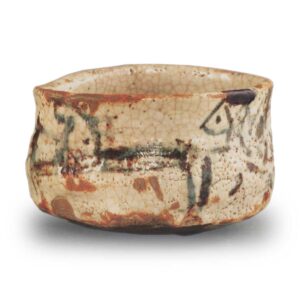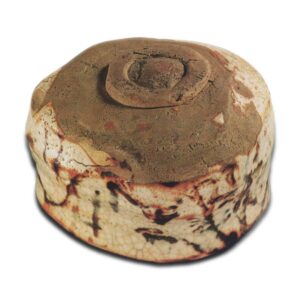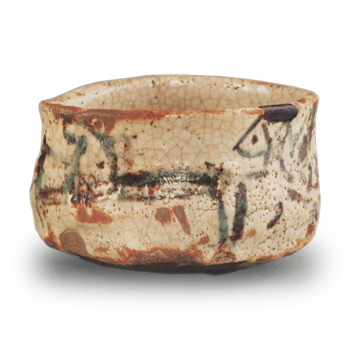

Height: 7.8-8.5cm
Diameter: 11.2-13.5cm
Outer diameter of foot ring: 5.3-5.9cm
Height of foot ring: 0.5cm
This Asahikage teacup is also thought to have been produced at the Mino Okaya kiln in the Momoyama period, which produced many famous Koshi ware pieces, including Uka-gaki, Asahagi, Hirosawa, Hagoromo, Sumiyoshi, Yamahata, and Minemomiji, and although it has introduced to the world, but in terms of the way the glaze has been applied, the color of the fire and the cast pictures, they are works of the highest quality that are just as good as the known works, and they are works that will surely satisfy the connoisseurs of Shino ware.
The name Asahikage is taken from a poem by the former Grand Minister of State, Tsunekazu, in the Keiga section of the Shinsenzai Waka Shu (New Thousand-Year Collection of Japanese Poetry), which reads “Please do not let the rising sun behind the mountains of Kamiji, which are still covered in the early morning mist, obscure the glory of the Imperial reign.” The mountain range in the distance, reminiscent of the mountain range of the Kamijiyama mountain range, combined with the magnificent reddish-brown scenery, gives the impression of the freshness of the early morning of New Year’s Day, when people visit the sacred precincts of Ise to pray for good fortune in the new year, and it is both divine and imbued with a deeper sense of the tea ceremony.
The white clay is covered in a soft feldspar glaze, and the body is beautifully decorated with a variety of cast-on designs, using a free-flowing brushstroke. This style, with a full skirt and a narrow mouth, can sometimes be seen in other Koshi ware from Okaya.
The mouth is slightly oval, and the overall shape is elongated, but the shaping is extremely unrestrained, and the touch of the blade on the body and the side-sculpting creates an attractive work.
The mottled painting that is drawn around the outside is a thick painting unique to Koshi ware, and as the motifs change, the tea-like charm never ends . The Shino glaze that covers the surface is soft and the coloring of the cast pictures varies in shade and tone depending on the thickness of the glaze, and the glaze pools, ripples, fingerprints and hearths add to the excitement. What is particularly noteworthy is that the distinctive charm of Koshiware, its brilliant fire-colored glaze, appears in various places, on the rim, in the cast-in pictures, or at the edge of the glaze, and allows the viewer to enjoy it to their heart’s content.
The interior is deep and spacious, and there are three eyes inside. The foot ring is a Koetsu-style foot ring, and the ten-character kiln mark is carved on it. The unglazed area around the waist, which is irregularly shaped, is also interesting as a work of art. There is a spot of lacquer repair on the rim.
The inner box is black lacquered, and the author of the paper pasted on the lid is unknown. On the reverse of the lid is a paper label with the words “Please do not let the morning sun on the mountain path of the ancient road of Chihaya be obscured by the clouds of the reign of the Emperor,” and the author of this is Yabuuchi Takesui.
Although the detailed history of its ownership is unknown, like many famous Shino bowls, it is a historic piece that was passed down through a famous family in Osaka, and it is currently in the possession of a tea ceremony enthusiast in the Hanshin area who is related to the name on the bowl.



